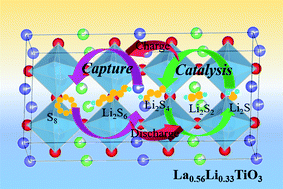Perovskite-type La0.56Li0.33TiO3 as an effective polysulfide promoter for stable lithium–sulfur batteries in lean electrolyte conditions†
Abstract
Lithium–sulfur batteries (LSBs) are promising candidates for next-generation energy storage equipment due to their high theoretical energy density. Nevertheless, the practical application of LSBs is heavily impeded by the high electrolyte to sulfur ratio necessary for catholyte-type controlled mechanism battery systems and to prevent severe polysulfide shuttling effects. To achieve high specific energy LSBs, it is vital to reduce the electrolyte dosage and slow the lithium polysulfide shuttling. Herein, the quick ion conductor La0.56Li0.33TiO3 (LLTO) with a perovskite structure is prepared via a sol–gel and high-temperature calcination method and used for the first time as an absorbent for polysulfides owing to its charged characteristics and as a catalyst for the polysulfide conversion reaction due to its structural characteristics. It has been found that LLTO exhibits a high ionic conductivity of 2.94 × 10−4 S cm−1 and plays a significant electrocatalytic role in the redox reaction of polysulfides in LSBs under lean electrolyte conditions. The co-existence of lithiophilic (O) and sulfiphilic (Ti) sites in LLTO can lead to a favorable interfacial affinity toward lithium polysulfides. Therefore, LSBs containing LLTO can readily reduce the electrolyte/active material ratio, accelerate the reaction kinetics, suppress the polysulfide shuttling and significantly reduce the overpotential for the charge/discharge process. This consequently results in the improved electrochemical performances of LSBs in terms of rate capability and cycling stability. LSBs can deliver a high initial capacity of 800 mA h g−1 at 0.8 mA cm−2 with a challenging electrolyte/sulfur ratio (E/S) of 5 μLE mgS−1 and an excellent capacity retention of 90.1% after 50 cycles under lean electrolyte conditions. Even at a higher current density of 2 mA cm−2, an acceptable capacity of 452 mA h g−1 can still be maintained, with a high coulombic efficiency of 96.7% after 100 cycles.

- This article is part of the themed collection: 2019 Journal of Materials Chemistry A HOT Papers


 Please wait while we load your content...
Please wait while we load your content...